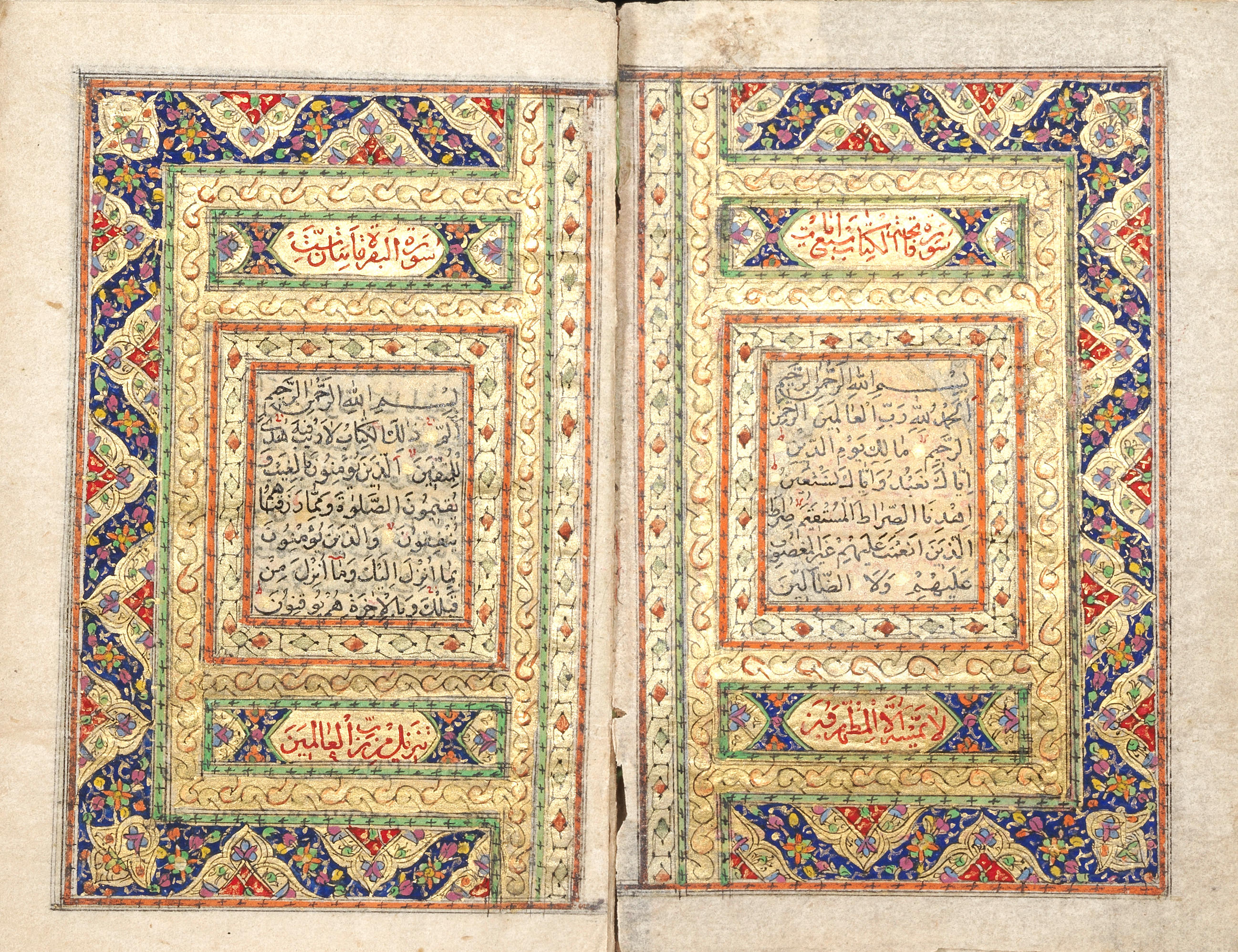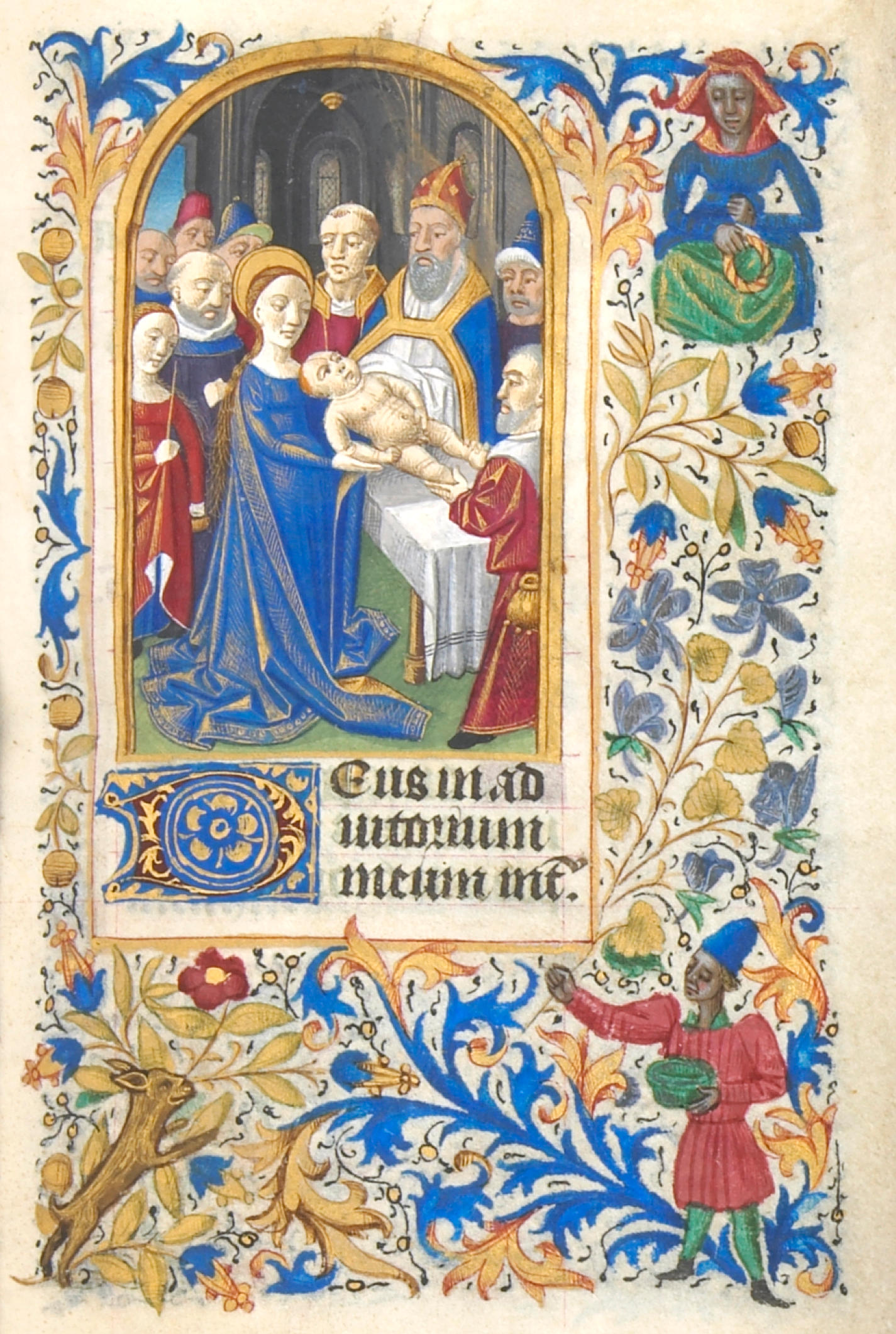TWO ILLUMINATED BORDERS incorporating a design by the Master of the Playing Cards, cut from a choirbook, illuminated manuscript on vellum[Austria (Danube Valley), late 15th century (c. 1480s)]
two cuttings, one (a) horizontal, c. 95 × 310mm, and one (b) vertical, c. 310 × 95mm, each with a fine illuminated foliage border, cut from the left and lower margins respectively of an unidentified manuscript, apparently from the same leaf, the reverse of (a) with a pair of vertical rulings in red on both sides, and small traces of gothic script and a flourished initial, the reverse of (b) with traces of four-line red staves and music in square notation, and inscribed in pencil ‘Mark Lansburgh, Santa Barbara, 1964 (Taos, N.M.)’; (a) with a bird and naturalistic stag with large antlers encountering semi-naturalistic winged insect, (b) with four naturalistic birds, a dragon-head, and a cartoon-like plant with a human face, the reverse of each with a blue ink-stamp ‘Lansburgh’ in capitals in an arch shape; framed with a label in Mark Lansburgh’s handwriting on the reverse of each.
PROVENANCEMark Lansburgh (1925–2013), teacher, hand-press printer, and book collector (on whom see Dutschke, 2024), apparently acquired in 1964: with his inscriptions and ink-stamps on the reverse of each; published by Lehmann-Haupt in 1966; sold in March 1989 to:The Boehlen Collection, Bern, MS 1410
ILLUMINATIONThe leftmost grey and pink foliage of the horizontal border matches the lowermost grey and pink foliage of the vertical border, showing that these two cuttings were originally part of the same page. The stag in the horizontal border is extremely close in design to, and clearly based on, one of the stags by the so-called Master of the Playing Cards: Lehmann-Haupt (1966, p. 26) reproduces the present cutting alongside the equivalent stag in the Hours of Catherine of Cleves (New York, Morgan Library, MS. M.917/945, fol. 90r), the Giant Bible of Mainz (Washington DC, Library of Congress, fol. 2v), and the model for all three, the engraving by the Master of the Playing Cards (the latter is also reproduced by van Buren & Edmunds, 1974, fig. 3, upper right stag). He concludes that ‘The style of the Lansburgh fragment indicates that the manuscript could well have originated in Mainz some time in the third quarter of the fifteenth century’ (p. 25).
The Master of the Playing Cards’ designs were widely used for such borders (see e.g. van Buren & Edmunds, 1974) and there is no reason to doubt that this was the present illuminator’s source, but the cards were also disseminated widely, so there is no reason to find a link with Mainz; in fact, as Eberhard König (1983) has shown, copies of the Gutenberg Bibles were usually not illuminated at Mainz, but at the city for which they were purchased.
The illumination of the present cuttings can instead be associated with the so-called ‘Schreier-Nachfolge’ in Austria; this can be divided into several imperfectly-defined groupings, including works attributed to the Morandus-Meister, the Engelbrecht-Meister, the Meister des Wolfgang-Missales, and the Meister des Koloman-Antiphonars. The present cuttings are very close in style to the latter group, published by Armand Tif: an incunable in Vienna (ÖNB, Ink. 18.A.13 Bd. 2, fol. 2r; reproduced by Tif, 2014, Abb. 10), for example, exhibits the same palette and leafy forms, it includes a stag derived from the Master of the Playing Cards, and it includes two human faces like cartoon characters that emerge out of the foliage, very much like the face in the vertical cutting here.
REFERENCESH. Lehmann-Haupt, Gutenberg and the Master of the Playing Cards (New Haven, 1966), at pp. 25–26, 67, plus the loose fold-out chart, and with the present stag motif stamped in gilt on the front cover.
D. Miner, The Giant Bible of Mainz, 500th Anniversary: April Fourth, Fourteen Fifty-Two – April Fourth, Nineteen Fifty-Two (Pennsylvania: Library of Congress, 1952)
A.H. van Buren and S. Edmunds, ‘Playing Cards and Manuscripts; Some Widely Disseminated Fifteenth-Century Model Sheets’, Art Bulletin, 56 (1974), pp. 12–30
E König, ‘The Influence of the Invention of Printing on the Development of German Illumination’, in Manuscripts in the Fifty Years after the Invention of Printing, ed. by J. B. Trapp (London, 1983), pp. 85–94, pls. 39–46.
A. Tif, ‘Der Illuminator des Koloman-Antiphonars: Zur Frage der Mobilität eines Buchausstatters im donauösterreichischen Raum um 1480’, in Wege zum illuminierten Buch: Herstellungsbedingungen für Buchmalerei in Mittelalter und früher Neuzeit, ed. by C. Beier and E.T. Kubina (Vienna, 2014), pp. 80–104 (available online).
C. Dutschke, ‘Mark Lansburgh: Collector and Seller of Medieval Manuscripts’, in Medieval Manuscripts and Their Provenance: Essays in Honour of Barbara A. Shailor, ed. by A.S.G. Edwards (Woodbridge, 2024), pp. 116–31.
TWO ILLUMINATED BORDERS incorporating a design by the Master of the Playing Cards, cut from a choirbook, illuminated manuscript on vellum[Austria (Danube Valley), late 15th century (c. 1480s)]
two cuttings, one (a) horizontal, c. 95 × 310mm, and one (b) vertical, c. 310 × 95mm, each with a fine illuminated foliage border, cut from the left and lower margins respectively of an unidentified manuscript, apparently from the same leaf, the reverse of (a) with a pair of vertical rulings in red on both sides, and small traces of gothic script and a flourished initial, the reverse of (b) with traces of four-line red staves and music in square notation, and inscribed in pencil ‘Mark Lansburgh, Santa Barbara, 1964 (Taos, N.M.)’; (a) with a bird and naturalistic stag with large antlers encountering semi-naturalistic winged insect, (b) with four naturalistic birds, a dragon-head, and a cartoon-like plant with a human face, the reverse of each with a blue ink-stamp ‘Lansburgh’ in capitals in an arch shape; framed with a label in Mark Lansburgh’s handwriting on the reverse of each.
PROVENANCEMark Lansburgh (1925–2013), teacher, hand-press printer, and book collector (on whom see Dutschke, 2024), apparently acquired in 1964: with his inscriptions and ink-stamps on the reverse of each; published by Lehmann-Haupt in 1966; sold in March 1989 to:The Boehlen Collection, Bern, MS 1410
ILLUMINATIONThe leftmost grey and pink foliage of the horizontal border matches the lowermost grey and pink foliage of the vertical border, showing that these two cuttings were originally part of the same page. The stag in the horizontal border is extremely close in design to, and clearly based on, one of the stags by the so-called Master of the Playing Cards: Lehmann-Haupt (1966, p. 26) reproduces the present cutting alongside the equivalent stag in the Hours of Catherine of Cleves (New York, Morgan Library, MS. M.917/945, fol. 90r), the Giant Bible of Mainz (Washington DC, Library of Congress, fol. 2v), and the model for all three, the engraving by the Master of the Playing Cards (the latter is also reproduced by van Buren & Edmunds, 1974, fig. 3, upper right stag). He concludes that ‘The style of the Lansburgh fragment indicates that the manuscript could well have originated in Mainz some time in the third quarter of the fifteenth century’ (p. 25).
The Master of the Playing Cards’ designs were widely used for such borders (see e.g. van Buren & Edmunds, 1974) and there is no reason to doubt that this was the present illuminator’s source, but the cards were also disseminated widely, so there is no reason to find a link with Mainz; in fact, as Eberhard König (1983) has shown, copies of the Gutenberg Bibles were usually not illuminated at Mainz, but at the city for which they were purchased.
The illumination of the present cuttings can instead be associated with the so-called ‘Schreier-Nachfolge’ in Austria; this can be divided into several imperfectly-defined groupings, including works attributed to the Morandus-Meister, the Engelbrecht-Meister, the Meister des Wolfgang-Missales, and the Meister des Koloman-Antiphonars. The present cuttings are very close in style to the latter group, published by Armand Tif: an incunable in Vienna (ÖNB, Ink. 18.A.13 Bd. 2, fol. 2r; reproduced by Tif, 2014, Abb. 10), for example, exhibits the same palette and leafy forms, it includes a stag derived from the Master of the Playing Cards, and it includes two human faces like cartoon characters that emerge out of the foliage, very much like the face in the vertical cutting here.
REFERENCESH. Lehmann-Haupt, Gutenberg and the Master of the Playing Cards (New Haven, 1966), at pp. 25–26, 67, plus the loose fold-out chart, and with the present stag motif stamped in gilt on the front cover.
D. Miner, The Giant Bible of Mainz, 500th Anniversary: April Fourth, Fourteen Fifty-Two – April Fourth, Nineteen Fifty-Two (Pennsylvania: Library of Congress, 1952)
A.H. van Buren and S. Edmunds, ‘Playing Cards and Manuscripts; Some Widely Disseminated Fifteenth-Century Model Sheets’, Art Bulletin, 56 (1974), pp. 12–30
E König, ‘The Influence of the Invention of Printing on the Development of German Illumination’, in Manuscripts in the Fifty Years after the Invention of Printing, ed. by J. B. Trapp (London, 1983), pp. 85–94, pls. 39–46.
A. Tif, ‘Der Illuminator des Koloman-Antiphonars: Zur Frage der Mobilität eines Buchausstatters im donauösterreichischen Raum um 1480’, in Wege zum illuminierten Buch: Herstellungsbedingungen für Buchmalerei in Mittelalter und früher Neuzeit, ed. by C. Beier and E.T. Kubina (Vienna, 2014), pp. 80–104 (available online).
C. Dutschke, ‘Mark Lansburgh: Collector and Seller of Medieval Manuscripts’, in Medieval Manuscripts and Their Provenance: Essays in Honour of Barbara A. Shailor, ed. by A.S.G. Edwards (Woodbridge, 2024), pp. 116–31.







.jpg)







Testen Sie LotSearch und seine Premium-Features 7 Tage - ohne Kosten!
Lassen Sie sich automatisch über neue Objekte in kommenden Auktionen benachrichtigen.
Suchauftrag anlegen